
CISSP: Achievement Unlocked
The Certified Information Systems Security Professional (CISSP) certification is a gold standard in the field of information security. Achieving CISSP is not just about passing an exam; it is about demonstrating a comprehensive understanding of cybersecurity concepts, principles, and practices. In this article, I’ll share my journey to achieving the CISSP certification, highlighting the preparation, challenges, and triumphs along the way.
The Decision to Pursue CISSP
Deciding to pursue the CISSP certification in Austin TX was not a spur-of-the-moment decision. The certification is well-respected and recognized globally, which aligns with my career goals in cybersecurity. I realized that having CISSP after my name would not only enhance my professional credibility but also open doors to more advanced and challenging roles within the industry.
Understanding the Requirements
Before diving into the preparation, it was crucial to understand the CISSP requirements. The International Information System Security Certification Consortium (ISC)², which administers the certification, requires candidates to have at least five years of cumulative, paid work experience in two or more of the eight domains of the CISSP Common Body of Knowledge (CBK). Fortunately, my professional experience in cybersecurity met this prerequisite.
The Eight Domains of CISSP
The CISSP exam covers eight domains:
- Security and Risk Management
- Asset Security
- Security Architecture and Engineering
- Communication and Network Security
- Identity and Access Management (IAM)
- Security Assessment and Testing
- Security Operations
- Software Development Security
Understanding these domains is fundamental to passing the exam. Each domain is extensive, requiring a deep understanding of various concepts and practical applications.
Creating a Study Plan
A structured study plan was imperative for me to cover all the material comprehensively. Here’s how I broke it down:
- Initial Assessment: I began by taking a diagnostic test to gauge my current understanding and identify weak areas. This helped me prioritize my study time effectively.
- Study Materials: I invested in quality study materials. The Official (ISC)² Guide to the CISSP CBK and CISSP Study Guide by Eric Conrad were my primary resources. Additionally, I subscribed to online platforms like Cybrary and used practice exams from Boson.
- Time Management: Given my full-time job, I dedicated two hours daily to studying and increased this to four hours on weekends. I set specific goals for each week, focusing on one domain at a time.
- Study Groups and Forums: Joining a study group was immensely beneficial. Interacting with peers preparing for the same exam provided different perspectives and insights. I also participated in online forums like Reddit’s CISSP community, which was a goldmine for tips and resources.
Deep Dive into Each Domain
1. Security and Risk Management: This domain is the foundation of information security. It covers risk management, security governance, compliance, and business continuity planning. I spent considerable time understanding risk assessment methodologies and legal regulations.
2. Asset Security: Protecting organizational assets, including data classification and handling, was crucial. I focused on understanding different types of data, their lifecycle, and how to protect them.
3. Security Architecture and Engineering: This domain was challenging due to its technical nature. It covers secure design principles, cryptography, and physical security. I revisited my fundamentals in cryptography and learned about the latest developments in secure architecture.
4. Communication and Network Security: Networking is the backbone of information security. I delved into network protocols, secure communication channels, and network attacks. Practical experience from my job helped solidify these concepts.
5. Identity and Access Management (IAM): IAM is about ensuring that only authorized individuals have access to resources. I studied authentication, authorization, and access control mechanisms extensively.
6. Security Assessment and Testing: This domain involves evaluating security measures. I learned about different types of security tests, including penetration testing and vulnerability assessments. Hands-on labs and simulations were particularly useful here.
7. Security Operations: Operational security includes incident management, disaster recovery, and logging. I created mock incident response plans and reviewed real-world case studies to understand effective security operations.
8. Software Development Security: Secure software development practices are essential. I focused on the software development lifecycle (SDLC), secure coding practices, and common vulnerabilities like SQL injection and cross-site scripting (XSS).
Practice, Practice, Practice
Practice exams were a cornerstone of my preparation. They not only familiarized me with the exam format but also highlighted areas where I needed improvement. I took multiple full-length practice exams, each time analyzing my performance and refining my study plan accordingly.
The Final Weeks
As the exam date approached, I shifted my focus to revision. I reviewed my notes, revisited challenging topics, and continued taking practice exams. I also made sure to rest adequately, as mental fatigue can impair performance.
Exam Day
On exam day, I felt a mix of nervousness and excitement. The CISSP exam is a grueling six-hour test with 250 questions, covering all eight domains. Time management was crucial. I tackled questions methodically, flagging difficult ones for review. Despite the length and complexity, I remained calm and focused throughout.
Post-Exam
After completing the exam, the wait for results began. (ISC)² usually takes a few weeks to process and release results. When I finally received the email confirming that I had passed, it was a moment of immense pride and relief.
The Impact of CISSP Certification
Achieving CISSP certification has had a profound impact on my career. It has validated my expertise in cybersecurity and boosted my professional credibility. I have received several job offers and opportunities for advancement within my organization. Moreover, the knowledge gained during the preparation has enhanced my ability to implement robust security measures and respond effectively to incidents.
Conclusion
The journey to achieving CISSP certification is challenging but immensely rewarding. It requires dedication, disciplined study, and a deep understanding of information security principles. For anyone considering this path, I can attest that the effort is well worth it. CISSP is more than just a certification; it is a testament to one’s commitment to safeguarding information in an increasingly digital world. With CISSP, the doors to advanced cybersecurity roles and opportunities are wide open, making the journey a worthwhile endeavor.


